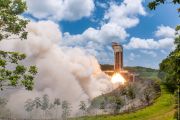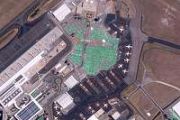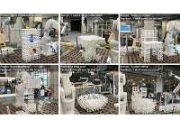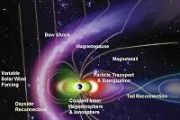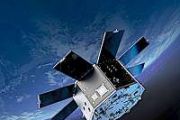
Copernical Team
Perseverance captures view of Mars' Belva Crater
 The Mastcam-Z instrument aboard NASA's Perseverance Mars rover recently collected 152 images while looking deep into Belva Crater, a large impact crater within the far larger Jezero Crater. Stitched into a dramatic mosaic, the results are not only eye-catching, but also provide the rover's science team some deep insights into the interior of Jezero.
"Mars rover missions usually end up expl
The Mastcam-Z instrument aboard NASA's Perseverance Mars rover recently collected 152 images while looking deep into Belva Crater, a large impact crater within the far larger Jezero Crater. Stitched into a dramatic mosaic, the results are not only eye-catching, but also provide the rover's science team some deep insights into the interior of Jezero.
"Mars rover missions usually end up expl Remotely waiting in Gale: Sols 3832-3833
 Earth planning date: Wednesday, May 17, 2023. As I'm writing this, it's about 8:30 pm on sol 3831 in Gale crater: ~16 hours after our SAM instrument ran its EGA experiment (which Abigail described so clearly in yesterday's blog!).
While we were able to confirm the success of the Ubajara drill sample drop-off to SAM and the start of the EGA, our first communication with Earth after the EGA
Earth planning date: Wednesday, May 17, 2023. As I'm writing this, it's about 8:30 pm on sol 3831 in Gale crater: ~16 hours after our SAM instrument ran its EGA experiment (which Abigail described so clearly in yesterday's blog!).
While we were able to confirm the success of the Ubajara drill sample drop-off to SAM and the start of the EGA, our first communication with Earth after the EGA Astronomers want your help hunting for asteroids
 Anyone can become an asteroid hunter thanks to a new program launched by astronomers at the University of Arizona Lunar and Planetary Laboratory. As part of the NASA-funded Catalina Sky Survey, the scientists created an online portal that opens their mission - the discovery and identification of space rocks that regularly visit Earth's neighborhood - to the general public.
While gazing up
Anyone can become an asteroid hunter thanks to a new program launched by astronomers at the University of Arizona Lunar and Planetary Laboratory. As part of the NASA-funded Catalina Sky Survey, the scientists created an online portal that opens their mission - the discovery and identification of space rocks that regularly visit Earth's neighborhood - to the general public.
While gazing up After 2 delays, SpaceX hopes next launch attempt will send satellites toward orbit
 SpaceX hopes to launch 22 satellites for a Starlink mission early Friday morning after previously suffering two delays.
The Falcon 9 rocket carrying the second-generation Starlink V2 Mini Internet satellites are scheduled to launch at 12:41 a.m. EDT from the Cape Canaveral Space Force Station in Florida, the company said in a news release.
If all goes well, the first stage booste
SpaceX hopes to launch 22 satellites for a Starlink mission early Friday morning after previously suffering two delays.
The Falcon 9 rocket carrying the second-generation Starlink V2 Mini Internet satellites are scheduled to launch at 12:41 a.m. EDT from the Cape Canaveral Space Force Station in Florida, the company said in a news release.
If all goes well, the first stage booste NASA begins feedback process for Moon to Mars Architecture
 As NASA builds a blueprint for human exploration throughout the solar system for the benefit of humanity, efforts to advance the agency's Moon to Mars architecture concept development approach are underway. NASA will host a virtual webinar at 2 p.m. EDT, Monday, May 22, in which leaders from the agency's Exploration Systems Development Mission Directorate will discuss how U.S. commercial industr
As NASA builds a blueprint for human exploration throughout the solar system for the benefit of humanity, efforts to advance the agency's Moon to Mars architecture concept development approach are underway. NASA will host a virtual webinar at 2 p.m. EDT, Monday, May 22, in which leaders from the agency's Exploration Systems Development Mission Directorate will discuss how U.S. commercial industr SpaceX Falcon 9 rocket deploys 22 second-generation Starlink satellites
 The first of two SpaceX missions planned to launch in less than seven hours took off early on Friday from Cape Canaveral, carrying 22 upgraded, new-generation Starlink broadband satellites.
Weather conditions delayed the original launch time from 12:41 a.m. EDT (0421 UTC) to 2:19 a.m. EDT (0619 UTC). The Starlink mission launched from Space Launch Complex 40 (SLC-40) at the Cape Canaveral
The first of two SpaceX missions planned to launch in less than seven hours took off early on Friday from Cape Canaveral, carrying 22 upgraded, new-generation Starlink broadband satellites.
Weather conditions delayed the original launch time from 12:41 a.m. EDT (0421 UTC) to 2:19 a.m. EDT (0619 UTC). The Starlink mission launched from Space Launch Complex 40 (SLC-40) at the Cape Canaveral Inmarsat announces FreeWave as Global IoT partner
 Inmarsat, a world leader in global, mobile satellite communications, has announced FreeWave Technologies - a leading Internet of Things (IoT) solutions provider - as a Distribution Partner for its L-band satellite IoT services.
The partnership, signed at this week's IoT Tech Expo in Santa Clara, California, will focus on the integration of Inmarsat's IsatData Pro (IDP) service in FreeWave'
Inmarsat, a world leader in global, mobile satellite communications, has announced FreeWave Technologies - a leading Internet of Things (IoT) solutions provider - as a Distribution Partner for its L-band satellite IoT services.
The partnership, signed at this week's IoT Tech Expo in Santa Clara, California, will focus on the integration of Inmarsat's IsatData Pro (IDP) service in FreeWave' Umbra and Ursa Space empower global market with advanced SAR Analytics
 Ursa Space Systems, a leader in satellite intelligence, and Umbra, a leader in advanced space radar technology, have jointly announced that they are partnering to bring advanced synthetic aperture radar (SAR) analytics to a global market through Ursa's suite of subscription and custom intelligence products.
The two companies first teamed up to serve customers in late 2022 when Umbra initia
Ursa Space Systems, a leader in satellite intelligence, and Umbra, a leader in advanced space radar technology, have jointly announced that they are partnering to bring advanced synthetic aperture radar (SAR) analytics to a global market through Ursa's suite of subscription and custom intelligence products.
The two companies first teamed up to serve customers in late 2022 when Umbra initia Accenture invests in SpiderOak to elevate satellite communications security in space
 Accenture (NYSE: ACN) has made a strategic investment, through Accenture Ventures, in SpiderOak, a leader in zero-trust cybersecurity and resiliency solutions for next generation space systems. Based in Reston, Virginia, SpiderOak's OrbitSecure product suite brings zero trust security to zero gravity environments. OrbitSecure leverages a powerful combination of no-knowledge encryption and distri
Accenture (NYSE: ACN) has made a strategic investment, through Accenture Ventures, in SpiderOak, a leader in zero-trust cybersecurity and resiliency solutions for next generation space systems. Based in Reston, Virginia, SpiderOak's OrbitSecure product suite brings zero trust security to zero gravity environments. OrbitSecure leverages a powerful combination of no-knowledge encryption and distri Arlula secures $2.2 million in seed funding to enable global space data access
 Australian space tech startup Arlula reports it has raised AUD$2.2 million (USD$1.5 million) to expand access to Earth Observation (EO) data and imagery, allowing individuals, small businesses and large enterprises alike to harness its full potential.
The funding was led by Main Sequence, Australia's deep tech investment fund founded by CSIRO, with participation from Black Nova Venture Cap
Australian space tech startup Arlula reports it has raised AUD$2.2 million (USD$1.5 million) to expand access to Earth Observation (EO) data and imagery, allowing individuals, small businesses and large enterprises alike to harness its full potential.
The funding was led by Main Sequence, Australia's deep tech investment fund founded by CSIRO, with participation from Black Nova Venture Cap 












